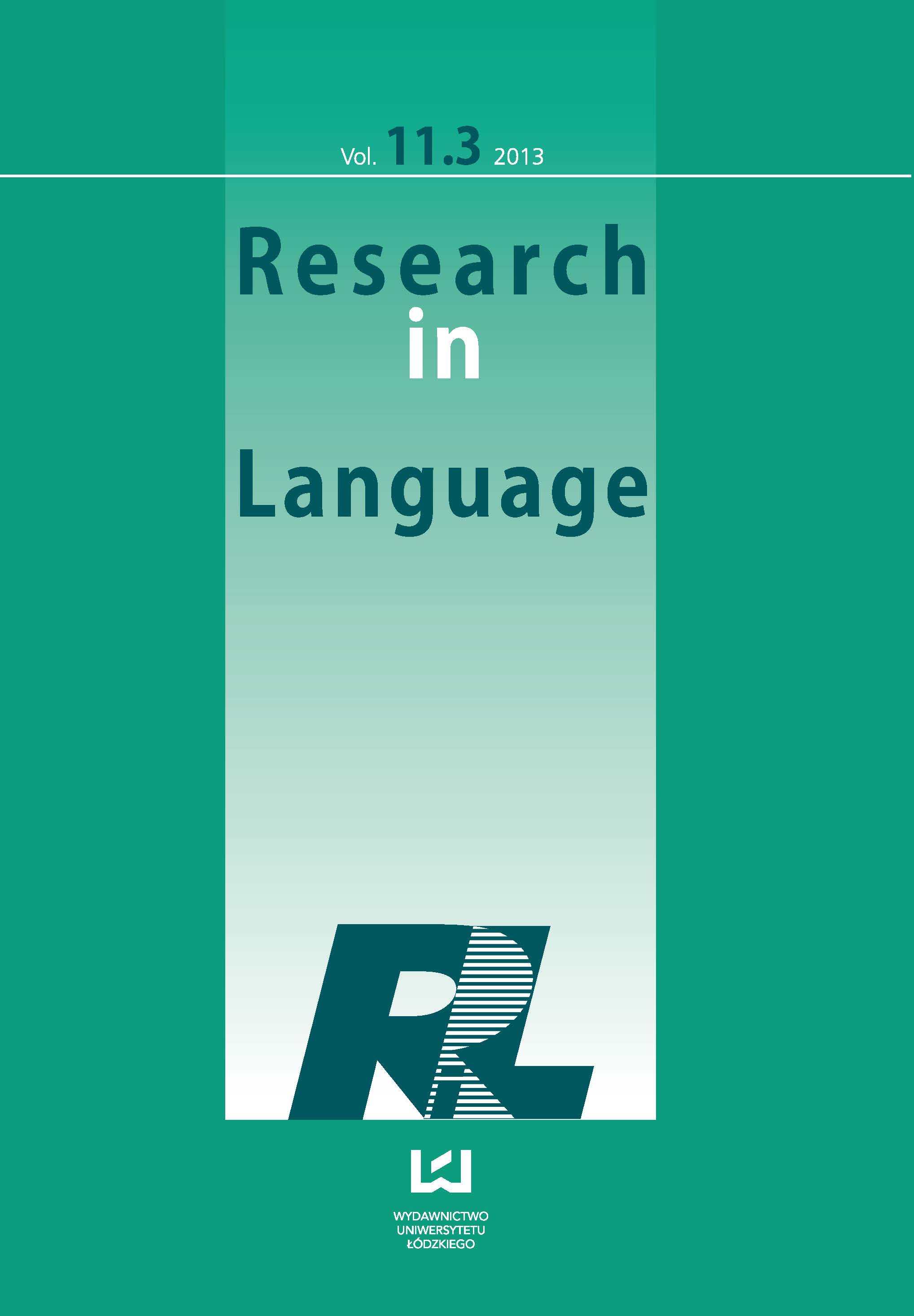Ellipsis as a Marker of Interaction in Spoken Discourse
DOI:
https://doi.org/10.2478/v10015-012-0020-xKeywords:
interaction, ellipsis, oral language, corpusAbstract
In this article, we discuss strategies for interaction in spoken discourse, focusing on ellipsis phenomena in English. The data comes from the VOICE corpus of English as a Lingua Franca, and we analyse education data in the form of seminar and workshop discussions, working group meetings, interviews and conversations. The functions ellipsis carries in the data are Intersubjectivity, where participants develop and maintain an understanding in discourse; Continuers, which are examples of back channel support; Correction, both self- and other-initiated; Repetition; and Comments, which are similar to Continuers but do not have a back channel support function. We see that the first of these, Intersubjectivity, is by far the most popular, followed by Repetitions and Comments. These results are explained as consequences of the nature of the texts themselves, as some are discussions of presentations and so can be expected to contain many Repetitions, for example. The speech event is also an important factor, as events with asymmetrical power relations like interviews do not contain so many Continuers. Our clear conclusion is that the use of ellipsis is a strong marker of interaction in spoken discourse.
References
Chun, Dorothy M. 1994. Using computer networking to facilitate the acquisition of interactive competence. System 22, 1: 17-31.
Google Scholar
Cogo, Alessia and Martin Dewey. 2012. Analysing English as a lingua franca: A corpus-driven investigation. London/New York: Continuum International Publishing Group.
Google Scholar
Cogo, Alessia. 2009. Accommodating difference in EFL conversations: A study of pragmatic strategies. In A. Mauranen and E. Ranta (eds.). English as a lingua franca: Studies and findings. Newcastle: Cambridge Scholars Publishing: 254-273.
Google Scholar
Corver, Norbert. 1990. The syntax of left branch extractions. PhD thesis, Katholieke Universiteit, Brabant.
Google Scholar
van Craenenbroeck, Jeroen. 2010. The syntax of ellipsis: Evidence from Dutch dialects. New York: Oxford University Press.
Google Scholar
Darhower, Mark. 2002. Interactional features of synchronous computer-mediated communication in the intermediate L2 class: A sociocultural case study. Calico, 19, 2: 249-277.
Google Scholar
Fernández-García, Marisol and Asuncion Martínez Arbelaiz. 2003. Learners’ interactions: A comparison of oral and computer-assisted written conversations. ReCALL, 15, 1: 113-136.
Google Scholar
Garcia, Paula. 2004. Meaning in academic contexts: A corpus-based study of pragmatic utterances. PhD thesis: Northern Arizona University.
Google Scholar
Heritage, John. 2005. Conversation analysis and institutional talk. In K. Fitch and R. Sanders (eds.). Handbook on language and social interaction. Mahwah, New Jersey: Lawrence Erlbaum Associates: 103-147.
Google Scholar
Holly, Werner. 1995. Secondary orality in the electronic media. In U. Quasthoff (ed.). Aspects of oral communication. Berlin: Walter de Gruyter: 340-363.
Google Scholar
Kramsch, Claire. 1983. Interaction in the classroom: Learning to negotiate roles and meanings. Die Unterrichtspraxis 16, 2: 175-190.
Google Scholar
Lave, Jean and Etienne Wenger. 1991. Situated learning: Legitimate peripheral participation. Cambridge, U.K.: Cambridge University Press.
Google Scholar
Lobeck, Anne. 1995. Ellipsis: Functional heads, licensing and identification. New York: Oxford University Press.
Google Scholar
Mauranen, Anna. 2006. Signalling and preventing misunderstanding in English as a lingua franca communication. International Journal of the Sociology of Language 177: 123-150.
Google Scholar
Mauranen, Anna. 2012. Exploring ELF: Academic English shaped by non-native speakers. Cambridge, U.K.: Cambridge University Press.
Google Scholar
Merchant, Jason. 2001. The syntax of silence. Oxford, England: Oxford University Press.
Google Scholar
Merchant, Jason. 2004. Fragments and ellipsis. Linguistics and Philosophy, 27: 661-738.
Google Scholar
Merchant, Jason. 2007. Three kinds of ellipsis: Syntactic, semantic and pragmatic? Available from: http://ling.auf.net/lingBuzz/000536
Google Scholar
Morita, Naoko. 2004. Participation and identity in second language academic communities. TESOL Quarterly 38, 4: 573-603.
Google Scholar
Oh, Sun-Young. 2005. English zero anaphora as an interactional resource. Research on Language and Social Interaction 38, 3: 267-302.
Google Scholar
Oh, Sun-Young. 2006. English zero anaphora as an interactional resource II. Discourse Studies 8: 817-846.
Google Scholar
Peterson, Mark. 2009. Learner interaction in synchronous CMC: A sociocultural perspective. Computer-Assisted Language Learning, 22, 4: 303-321.
Google Scholar
Pölzl, Ulrike and Barbara Seidlhofer. 2006. In and on their own terms: the “habitat factor” in English as a lingua franca interactions. International Journal of the Sociology of Language 177: 151-176.
Google Scholar
Ross, John Robert. 1967. Constraints on variables in syntax. PhD thesis, MIT.
Google Scholar
Scollon, Ron and Suzanne Scollon. 1995. Somatic communication: How useful is ‘Orality’ for the characterization of speech events and cultures? In U. Quasthoff (ed.). Aspects of oral communication. Berlin: Walter de Gruyter: 19-29.
Google Scholar
Scott, Kate. 2013. Pragmatically motivated null subjects in English: A relevance theory perspective. Journal of Pragmatics 53: 68-83. http://dx.doi.org/10.1016/j.pragma.2013.04.001
Google Scholar
Stainton, Robert. 2006. Words and thoughts: Subsentences, ellipsis and the philosophy of language. Oxford, England: Clarendon.
Google Scholar
Suviniitty, Jaana. 2012. Lectures in English as a lingua franca: Interactional features. PhD thesis: University of Helsinki.
Google Scholar
VOICE. 2011. The Vienna-Oxford International Corpus of English (version 1.1 Online). Director: B. Seidlhofer; Researchers: A. Breiteneder, T. Klimpfinger, S. Majewski, R. Osimk, M.-L. Pitzl. http://voice.univie.ac.at (date of last access, 1 March 2013).
Google Scholar
Wenger, Etienne. 1998 Communities of Practice: Learning, Meaning and Identity. Cambridge: Cambridge University Press.
Google Scholar
White, Jonathan. 2011. Reduced forms in chat discourse. In A. Ylikiiskilä and M. Westman (eds), Language for the Future: Papers from the ASLA Symposium in Falun 12-13 November, 2010: 231-247.
Google Scholar
White, Jonathan. 2013. Language economy in computer-mediated communication: Learner autonomy in a community of practice. In B. Zou, M. Xing, C. Xiang, Y. Wang, M. Sun (eds.). Computer-assisted foreign language teaching and learning: Technological advances. Hershey, Pa.: IGI Global: 73-89.
Google Scholar
Downloads
Published
How to Cite
Issue
Section
License

This work is licensed under a Creative Commons Attribution-NonCommercial-NoDerivatives 4.0 International License.










